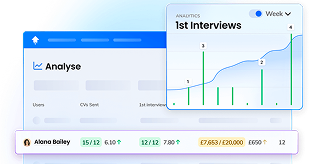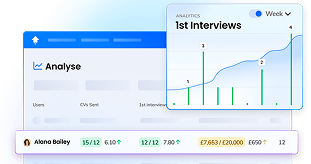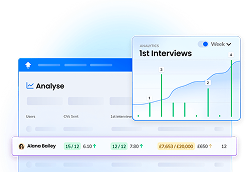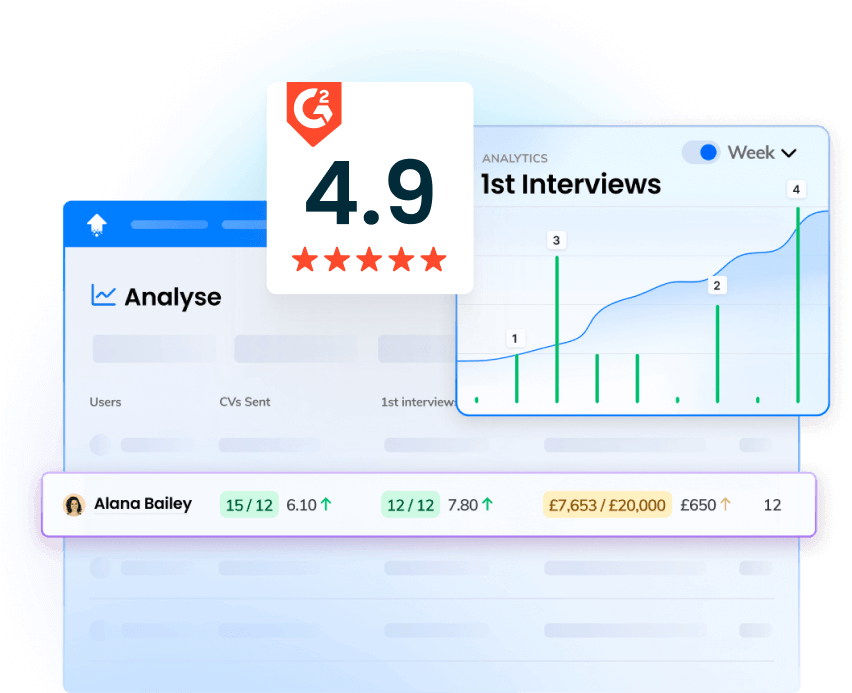Outbound recruiting is a highly targeted, deeply personalised recruitment technique perfect for tapping into the talent market of 2024.
In this competitive recruitment landscape, recruiters have to deliver only the highest-quality hires to their clients.
Meanwhile, top candidates expect recruiters to be invested in helping them to hit their career goals, and to deliver personalised communications.
Outbound recruitment can deliver on both the client and candidate fronts, expanding talent pools and improving agency hiring outcomes.
Read on to learn more about the benefits and challenges of outbound recruiting, and how your agency can use this approach to transform its strategy.
What is Outbound Recruiting?
In years gone by, recruiters would put out a job advertisement and wait for the CVs from hopeful applicants to flood in.
At this point, the real work would start.
But as the recruitment landscape has become more competitive, recruiters have sought to get ahead of their rivals with outbound recruitment — adding a new dimension to their role.
Outbound recruiters actively seek out, identify and engage potential candidates.
This proactive approach is helpful for tapping highly desirable candidates before the competition, and significantly broadens the scope of recruiters' talent pools.
Why Outbound Recruiting is Important for Hiring Agencies
Outbound recruitment allows hiring agencies to be more selective and targeted in their recruitment efforts.
Instead of simply choosing the best candidates from the CVs they receive in response to an ad, they put effort into actively finding the best candidates for the job description.
This is especially important when recruiting for high-value roles.
One major strategic advantage of outbound recruiting is that it allows reps to discover passive candidates who are not actively seeking new opportunities.
These candidates may be pretty happy in their current jobs but open to moving for the right role or a more attractive compensation package.
Alternatively, now might not be a good time for a passive candidate to switch jobs — but by engaging with them through outbound recruiting and nurturing the relationship, you can ensure you are front of mind when the time comes for a change.
Inbound vs Outbound Recruiting: Key Differences
Inbound and outbound recruitment each play a crucial role within agency strategy — but there are several key differences to be aware of.
#1 Reactive vs proactive
This is the core difference between inbound and outbound recruiting.
With inbound recruiting strategies, you aim to attract the top candidates for your client briefs.
But with outbound, you proactively seek candidates with specific skill sets and experience.
#2 Personalisation
Outbound recruiting is a much more personalised approach than inbound.
When taking an inbound approach, recruiters often cast their net wide to attract a broad range of candidates.
As outbound recruitment allows you to directly target specific potential candidates, you can take a much more personalised — and effective — approach.
Harness deep personalisation to engage the candidate, from learning about their skills and experience — and integrating this knowledge into your communication — to using language appropriate for their level of seniority.
Think about it — are you more likely to respond to a recruiter who sends you a (clearly) generic message about a role or one that uses your name and mentions specific details about your professional background?
#3 Where you dedicate your time
Inbound recruiters do the majority of their work post-application. This means sorting through many CVs and carefully selecting the best matches.
However, with outbound recruiting, most work occurs before the application stage.
You need to explore the client brief and then search your database, CV banks, and social media for professionals who fit the bill. You then need to successfully engage them and encourage them to apply for the role.
However, as an outbound recruiter works with a far smaller pool of candidates than those taking an inbound approach, you'll save yourself work down the line. You won't spend hours screening endless CVs, as you've already identified the perfect match.
Benefits of Outbound Recruiting
Outbound recruiting offers a wide range of advantages for agency recruiters.
Here are five of the biggest advantages to taking an outbound approach:
#1 Targeted Talent Engagement
During an inbound recruitment process, a wide variety of candidates who believe they meet a job ad's criteria will apply.
But outbound sourcing is much more targeted.
As the recruiter for a role, you are an expert on exactly what the client wants and needs from their new hire, from skills and experience to character traits and personality.
This makes you the best person to identify candidates with specific skills and experience levels that align with your client's needs.
It means you can target potential candidates who are genuinely the best fit for the role — including many professionals who may never have applied had you not reached out.
#2 Faster Time-to-Hire
Outbound recruitment can significantly reduce time-to-hire, speeding up your recruitment funnel.
First, reaching out to candidates personally is a much quicker way to determine whether they are interested in a role.
Building a personal relationship with them can also help you speed up the application process. First, help the potential candidate to see why securing the role would be a wise career move for them, and then — once they're keen to apply — you can set application deadlines and check in on their progress.
Furthermore, engaging with passive candidates who may not be actively looking but are open to opportunities can also speed up time-to-hire for future roles.
By building relationships with passive potential candidates, you establish a roster of top talent you can quickly tap into should the right job vacancy arise.
#3 Higher Quality of Hires
More focused searches result in higher-quality hires.
Why?
Recruiters are not simply selecting the best candidates from the applicants who happen to spot the job advertisement and apply.
Instead, they identify the best fit for the role from all the professionals on LinkedIn and within online CV databases.
A highly targeted search in this vast talent pool should result in a much higher-quality candidate pipeline and a very satisfied agency client.
#4 Meeting Challenging Recruitment Needs
Similarly, recruiters can vastly increase the likelihood of finding the best fit for specialised and senior roles through highly targeted searches.
When hunting for potential candidates for roles with a high level of compensation, recruiters and hiring managers have a lot on the line.
If recruiters deliver unsuitable CVs or sub-par candidates for interviews, the hiring manager will likely lose confidence in their agency.
By taking an outbound approach, recruiters can ensure they only select genuine top talent that meets specific client requirements and verify their credentials before reaching out.
#5 A Direct Line to Your Agency
When approaching candidates via call, email, text, or LinkedIn, you give potential candidates a direct line to your recruitment agency.
From a candidate's perspective, contacting a faceless recruitment agency with a question about a role could seem intimidating.
But by building relationships with potential candidates, recruiters humanise their agencies, and ensure professionals feel comfortable contacting them.
Challenges and Drawbacks of Outbound Recruiting
Of course, recruitment is never straightforward — and there are several challenges regarding outbound recruiting.
Here are three key drawbacks to consider before adopting an outbound strategy.
- Resource-intensive. Outbound recruiting typically requires more time initially than inbound methods, as recruiters must put significant effort into identifying and engaging candidates from across the web to achieve the desired results.
- Higher Skill Requirement. Taking an outbound approach requires recruiters with solid sales and marketing skills — in addition to recruitment skills — to effectively engage potential candidates. Recruiters will need ongoing training to continuously improve their outbound efforts.
- Potential for Lower Candidate Interest. When performing outbound recruiting, sometimes you can feel like you're wasting precious working hours. Many candidates you contact will not be interested in the position or ready to move into a new role. Working with fewer candidates can shock recruiters, who usually receive hundreds of CVs for every opening.
How to Implement Outbound Recruitment: Step-by-Step Instruction
Here's a simple four-step plan for implementing outbound hiring within your agency.
#1 Identify Your Target Candidate Persona
Start by creating your target candidate persona.
Depending on your agency's niche, this may represent an ideal candidate for one single role (in which case you will need to repeat this step with every job added) or, more generally, for roles you commonly hire into.
To craft a target candidate persona, you first need to understand the specific attributes of the ideal candidates for your roles.
Start by considering your client's needs, challenges, and pain points and thoroughly investigating their brief and job ad.
You may also want to use historical data to reveal which candidates have been most successful once placed in similar roles. Then, incorporate the attributes of those candidates into your target candidate persona.
Your target candidate person should include:
- Educational level
- Specific qualifications required
- Level of industry experience required
- Skills required
- Communication style
- Culture fit
#2 Develop a Messaging Strategy
Now that you know which candidates to target, you can determine how best to engage them.
Craft personalised messages that will resonate with your target persona.
Regarding personalisation, leave space for important details such as their name, job title, and experience.
For best results, you should write a hyper-personalised opening sentence that clarifies that you've researched the potential candidate and their professional background.
It's essential to ensure your tone of voice is spot on, too.
For example, a potential candidate for a role with a high level of seniority may be put off if you communicate in too casual a manner or use unprofessional language or slang.
Conversely, when targeting recent graduates, you may have more success if you take a more informal approach.
#3 Choose the Right Channels
Where does your ideal candidate hang out online and off?
Are you most likely to successfully engage them:
- On social media, such as LinkedIn or X (formerly Twitter)
- On industry-specific forums such as webinars or online conferences
- At professional events such as conferences or lectures
#4 Launch Targeted Campaigns
Launch your targeted outreach campaigns once you've nailed your messaging and identified the best sourcing channels.
Tracking the results of your campaigns is critical to their success.
Track your open and response rates, A/B test different opening messages, and adjust tactics as needed.
5 Proven Outbound Recruiting Strategies
Here are five outbound recruiting strategies bound to help you get results.
#1 Desktop Research
There's little point wasting time reaching out to professionals who will not be a good fit.
In the long run, you can save yourself a lot of time by becoming a whizz at desktop research.
Before adding contacts to your outreach list, use their social media profiles and online CVs to answer the following questions:
- What is their current employment status?
- Do their skills match the target candidate profile?
- Does their experience match the target candidate profile?
- Do they have strong communication skills online?
- What are their career aspirations?
- How are they reviewed by former managers and colleagues (for example, on LinkedIn testimonials)
If any information you discover during the research process suggests they would not be a good fit for the role you're hiring into, eliminate them from the outreach process and move on to better-qualified candidates.
#2 Personalised Communication
When contacting potential candidates, use tailored messaging that clarifies that you have researched the professional in question and are keen to help them progress in their career and reach their goals.
They are much more likely to respond if you demonstrate that you have researched their skills and experience and are confident they would be a good fit for the position.
The tone of voice of your communication should also be personalised to the seniority and experience of the potential candidate in question.
When communicating by email, remember to personalise the subject line to boost your open rate.
#3 Building Your Own Contact Lists
Many recruitment agencies simply buy email lists in a bid to speed up the outreach process.
But this is unlikely to reap the results you seek.
Anonymous email lists do not enable the precise level of targeting required for a successful outbound campaign.
What's more, they don't allow for meaningful personalisation and can return high bounce rates, which can lead to the blocking of your email domain, jeopardising future outreach campaigns.
Instead, build your verified email list by handpicking top talent on platforms like LinkedIn. Then, use an email finder tool to identify your potential candidates' verified email addresses.
#4 Engagement Tracking
The effectiveness of your outbound recruitment strategy must be tracked and continuously improved.
Monitor interactions and measure engagement levels to refine your approach.
Here's a simple example.
Imagine you want to A/B test two LinkedIn messages for a role you are currently hiring for.
Send Message 1 to one-quarter of your email list and Message 2 to another quarter.
Measure how many responses you get to each message.
Say Message 1 has a 20% response rate within 24 hours, and Message 2 has a 10% response rate within 24 hours.
You can now send Message 1 — the 'winning' message — to the other half of your list — in theory, this should boost your engagement rate.
In order to ensure accurate results, it's worth investing in data analytics tools to track key metrics.

Read more: The State of Recruitment 2024 — Trends & Benchmarks Report
#5 Continuous Follow-Up
If a potential candidate has responded to your communication, you're already most of the way there.
You must now strive to keep these potential candidates engaged and interested in your agency.
This is where your follow-up strategy comes in handy.
This should be a standardised process followed by every recruiter.
Cutting-edge tech tools that perform email sequencing can boost your follow-up process.
This means that when potential candidates agree to receive your communication, they will automatically be entered into an email sequence designed to keep them engaged.
This could include:
- Introductions to different members of staff at your recruitment agency
- An insight into company culture
- Weekly round-ups of jobs that could be relevant to them
- Industry news and thought leadership
Discover more creative recruiting ideas here.
6 Tools to Automate and Scale Outbound Recruitment
There are a variety of tech tools on the market that empower you to automate and scale your outbound recruitment.
These typically fall into two categories:
- CRM systems, which efficiently track and manage candidate data and interactions
- Automated outreach tools, which allow you to automate initial contact and follow-up processes in order to scale outbound efforts
Here are some of the top tools to consider for each purpose.
CRM Systems
#1 Vincere

Vincere is a simple, scalable platform, which streamlines candidate management, client collaboration, and job placements with a comprehensive view of the whole recruitment cycle.
It boasts an outstanding lead management system, complemented by automated workflows, as well as automatic logging of all client and candidate comms, an insightful data analysis tool, and timesheet and invoicing integration.
Furthermore, it integrates seamlessly with OneUp, empowering recruiters to manage their performance in real-time.
#2 JobAdder

With JobAdder, recruiters can seamlessly import, create and update opportunity information, capture and nurture inbound leads, view the status of any deal, assign deals to any user, and transfer deal ownership.
There’s a single-click process for transferring a closed won deal into a new job record, meaning you can kick off the hiring process in record time.
JobAdder also boasts a whole host of integrations, including OneUp.
#3 Loxo

Loxo’s recruiting CRM is designed to supercharge your processes, with automatic database updates and sourcing and workflow automation.
Within the platform, which integrates with OneUp, recruiters can build and search a talent database, nurture the talent within this database and manage their daily workflow.
All recruitment activities and historic communications are stored in one centralised location, while a powerful search function ensures you’re working only with the most relevant and up-to-date information.
Automated Outreach Tools
#4 Manatal
Manatal is an AI recruitment software designed to source and hire candidates faster.
With Manatal you can share job openings on 2,500+ free and premium channels, including local, global, and specialised job platforms, converge all candidates on one platform, and automate the creation of candidate profiles.
Automate the extraction and classification of candidate information, and tap into one-click sourcing via social media sharing.
Meanwhile, a handy Chrome extension allows you to import candidate profiles directly from LinkedIn.
#5 Leonar
Leonar is an all-in-one tool that extracts, cleans, enriches and sorts candidate data across multiple platforms.
What’s more, this software enables recruiters to launch powerful messaging sequences across email, LinkedIn messages, and LinkedIn InMails.
In addition to generating outreach sequences, Leonar’s AI technology enables you to hyper-personalise each message, build Boolean queries, and write interview briefs.
Its powerful filtering capabilities mean you can target the right candidates for the role with deeper precision.
#6 hireEZ
hireEZ boasts an AI-powered candidate search that allows you to source the best talent across the open web and your ATS.
Its applicant matching facility uses generative AI to strengthen the accuracy of your targeting, while recruiters are able to customise their preferences to find the best fit.
With hireEZ, you can create personalised, AI-generated outreach campaigns across multiple channels including email, newsletters, text, and InMail.
Its Intelligent Talent Pools feature, meanwhile, allows recruiters to instantly gauge candidate interest levels, and improve talent nurturing based on recommendations.
Measuring Outbound Recruitment Effectiveness
Meticulously measuring the effectiveness of your outbound recruiting strategy is crucial to success.

If you're unaware of what is and is not working, making vital improvements is nearly impossible.
But armed with the right data, you can refine your outbound strategy to near perfection.
So, which recruitment metrics should you be tracking for outbound?
- Open rates show the percentage of potential candidates who are opening your emails and messages
- Response rates reveal how many potential candidates are replying to direct messages and emails
- Click-through rates tell you how many email recipients are clicking through to links within your email (such as a link to a job opening)
- Conversion rates can be used to identify how many potential candidates you need to reach out to in order to get one job applicant, one fully qualified candidate, one first interviewee, or one hire

This data should be used to continuously refine and improve your outbound recruiting strategies.
For example, if your open rate is low, consider personalising your subject lines or making them more attention-grabbing.
If your response rates are low, should you include a clear call to action when replying to the email?
A low click-through rate suggests that you may need to include the links higher up in your emails, signpost them more clearly, and sell them harder.
Meanwhile, low conversion rates suggest you should dive into the data to find out what part of the process is failing. Perhaps potential candidates are responding to messages but dropping out at the application stage, for example? Find out why your conversion rate is low, and you'll be able to tackle the issue in question before it escalates.
Use recruitment analytics tools like OneUp to automate reporting to ensure data is always front of mind and central to decision-making.
Closing Thoughts: Enhancing Outbound Recruiting with OneUp
Outbound recruitment is a highly targeted, personalised approach, perfect for tapping top talent in 2024.
If your agency frequently has specialised, senior, and/or high-value vacancies, you can't afford to transform your recruitment process with an outbound strategy.
To make this approach a success, cutting-edge tools are vital.
Recruitment analytics software OneUp integrates seamlessly with recruitment CRMs.
With OneUp, you can easily measure the impact of your outbound approach on a seamless, intuitive interface — and continuously improve your techniques.
In addition to data analytics, OneUp offers useful performance tracking and gamification features to streamline your processes and motivate recruiters to perform at a high standard.
Interested in learning more about how OneUp could enhance your outbound recruitment strategy? Book your demo here.




















